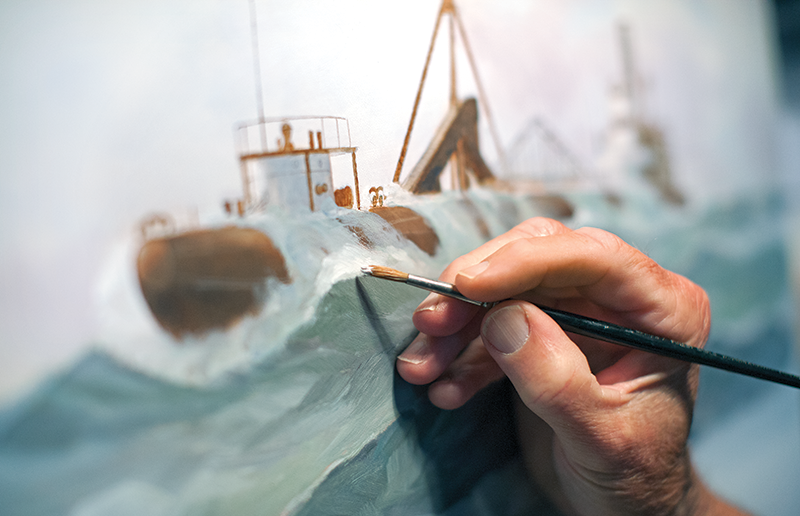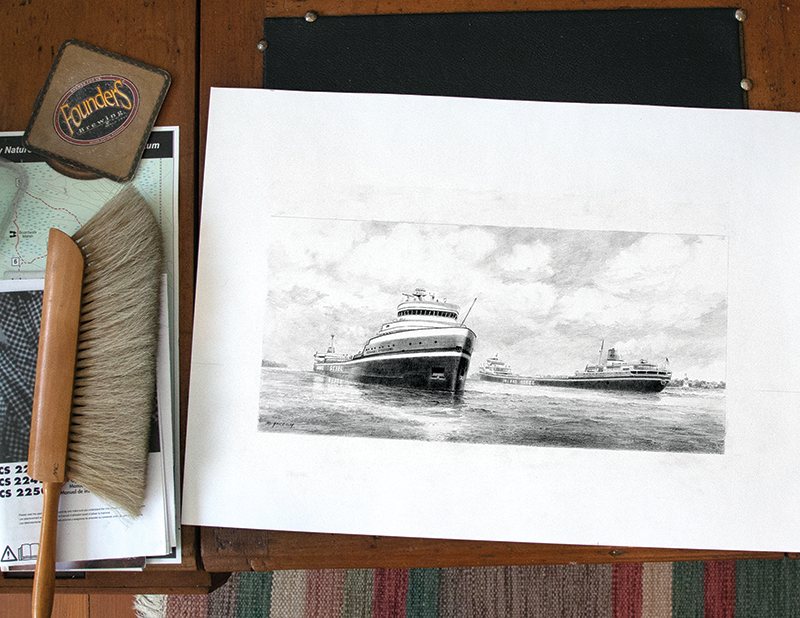
Throughout a creative life that spans nearly half a century, Michigan-based maritime artist Robert McGreevy has quietly evolved into something of a freshwater renaissance man.
Considered one of the Great Lakes region’s “living masters” by curators and collectors, McGreevy breathes life into historic lake vessels above and below the not-always-placid surface of America’s inland seas.

McGreevy has deliberately broadened the scope of his work over the past four decades, becoming not only a master of watercolor and oils, but a rigorous historical researcher, nautical collector, lighthouse society booster, museum-caliber scale ship builder and, lately, Great Lakes shipwreck detective.
“Shipwreck detecting is a lot like being a real cop,” said McGreevy with a weary shrug. “Hours and hours of boredom towing the sonar followed by explosive excitement when months or years of research pays off.”

Multifaceted family ties to maritime history roll back three full generations on two continents for McGreevy. In Northern Ireland, his grandfather worked as a ship’s carpenter during construction of the R.M.S. Titanic. A pair of his uncles were recruited from the Harland & Wolff yard in Belfast to help drive rivets on the Edmund Fitzgerald and Mackinac Bridge in the late 1950s. McGreevy’s father worked as a machinist at Great Lakes Engineering Works at Wyandotte — a builder of freshwater vessels of all sizes and types. Even his father-in-law was first chair percussionist aboard the beloved Detroit River excursion steamer Tashmoo, which, in a feat of cosmic symmetry, just happens to be McGreevy’s favorite lake vessel of all time.
“The careful attention to the smallest historical detail, and care he takes to place the vessel in its historic context is what makes the paintings true masterpieces.”
CHRIS GILLCHRIST
McGreevy spent his childhood along the Detroit River, sketching the lake boats (freighters) as they steamed past — one about every five minutes in those years. His talent was evident early on, and he attended Cass Technical School where he began honing a draftsman’s chops. A distinguished career in Chrysler’s design studio followed; McGreevy was responsible for sculpting the iconic hood ornament of the Dodge Ramcharger pickup truck among other notable automotive styling feats.
When McGreevy retired from Chrysler in the summer of 2000, he and his wife, Suzanne, moved their home and his studio from Grosse Pointe to a rambling 1920s-era farmhouse on the Lake Huron shore just north of Harbor Beach. McGreevy’s work is prized by collectors for its serene color palate, elegant composition and fine draftsmanship, and also for its scrupulous historical accuracy. In fact, McGreevy considers himself a historian first, artist second.


“If the painting of a vessel includes the landscape of a city or harbor, Bob will pick a particular day that that scene was to have occurred, and then meticulously scour the historical record to find out what buildings were there on the shoreline at that time, and what colors the buildings were, and what the weather conditions were on that particular day,” said Mac McAdams, president of the Great Lakes Maritime Institute, an avid collector of McGreevy’s originals.
Chris Gillchrist, executive director of the National Museum of the Great Lakes, adds: “Bob McGreevy works the rare magic of bringing historic vessels to life. The careful attention to the smallest historical detail, and care he takes to place the vessel in its historic context is what makes the paintings true masterpieces.”
Now able to pursue his avocation full time, McGreevy’s commissions — over 400 to date — have encompassed all periods of Great Lakes vessel design and development. The ornate pre-Civil War-era wooden vessels and the great passenger steamers of the Detroit and St. Clair rivers remain his favorite challenge.

With few photographs to record the appearance of these early Great Lakes vessels, McGreevy will roll up his sleeves and drill down into contemporary newspaper accounts and tedious bundles of vessel enrollment paperwork before deploying his technical training in drafting and perspective to re-animate the past. He cites 19th-century master Howard Sprague as the peer he most admires.
“He had a way of capturing water that really comes alive on the canvas,” McGreevy said. “He was working before cameras, and I think he must have just internalized the way the water moves — a shimmering, liquid quality shines through.”

The roots of McGreevy’s own maritime oeuvre rose from the bottom up. His first official commission illuminating Great Lakes maritime lore came in 1979, after legendary Great Lakes wreck hunter David Trotter discovered both halves of the big lake steamer Daniel J. Morrell in a single day. The wreck lies in 200 feet of water about 15 miles northeast of the Harbor Beach breakwall. The Morrell broke in two and sank in a fierce November gale in 1966, taking all but one of her crew of 29 with her when she plunged. McGreevy spent months creating detailed drawings of both wreck sites (the bow and stern sections are separated by nearly five miles) and several dramatic perspectives of the vessel breaking up in heavy seas.
New divers take for granted the Caribbean-esque post-quagga mussel visibility in northern Lake Huron now, and the high-fidelity underwater digital imaging gear available to virtually any serious enthusiast. “I cringe a little bit every time I look at those original drawings,” McGreevy chuckles. “In those years divers got excited by five or eight feet of visibility. We did the best we could to piece the huge wreck site together, fuzzy 35mm slide by fuzzy 35mm slide, 8 feet at a time. Initially, we weren’t even sure we had the right shipwreck. We were comparing the underwater stills to blueprints, and nothing matched. Then we realized we were looking at the slides backwards.”
McGreevy also remembers a Pleistocene era before online databases. “Research was much more hands-on when I started out. I used to rack up long-distance phone bills, and drive the wheels off the car… Given the amount of authentic primary source detective work involved, by the end of a project you really felt like you had contributed to the historical record.”

In recent years, McGreevy’s interdisciplinary approach to maritime history has found him volunteering significant tracts of time creating original artwork to benefit the Thumb Area’s Point Aux Barques and Harbor Beach Lighthouse societies. Last autumn, McGreevy’s painting of the Harbor Beach Light as it would have appeared in 1913, the year of the “White Hurricane” on Lake Huron, raised $10,000 at auction. It also found him teaming up with some of the most prolific shipwreck hunters in the Great Lakes region.
McGreevy’s knack for historical research will often bring to light clues relevant to where a particular vessel met her end, sparing hundreds of hours of fruitless “mowing the lawn” with the sonar gear. As a payoff, illustrating a newly discovered underwater site provides McGreevy with a unique creative challenge, and divers can occasionally help shed light on the colorful livery of nineteenth-century vessels. Glimpses of paint extracted from photo and video captures of underwater sites confirm what splendid ships they must have been in an era before color film. Or film, period.

After 40-plus years at the easel, McGreevy has collected a mantle full of honors and awards. He was named 2004 Great Lakes Historian of the Year by the Marine Historical Society of Detroit, and Alcona County Michigan named him its Historian of the Year in 2008. He’s served as a board member of the Great Lakes Maritime Institute and was named a Shook Award recipient for his work with the Pointe aux Barques Lighthouse Society. McGreevy published his excellent chronicle of doomed lake vessels “Lost Legends of the Lakes” in 2009, and has been a contributing author to many publications, including the State History Award-winning book on the history of Huron County. Visit his website (mcgreevy.com) for information on the artist’s upcoming speaking events, an updated project blog and information on how to purchase limited edition prints. ≈
Christopher Winters is a Wisconsin-based author and photographer with a passionate interest in Great Lakes maritime history.







Facebook Comments